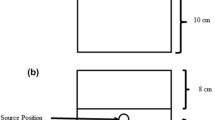Abstract
It was the aim of the study to verify dose delivered in urethra and rectum during High Dose Rate brachytherapy boost (HDRBB) of prostate cancer patients. During the first fraction of HDRBB measurement catheters were placed in the urethra and rectum of prostate cancer patients. These contained LiF:Mg,Ti Thermoluminescence Dosimetry (TLD) rods of 1mm diameter, with up to 11 detectors positioned every 16 mm separated by radio-opaque markers. A Lorentzian peak function was used to fit the data. Measurements from 50 patients were evaluated and measured doses were compared with predictions from the treatment planning system (Plato Vs 13.5 to 14.1). Prospective urinary and rectal toxicity scores were collected following treatment. In more than 90% of cases, the Lorentzian peak function provided a good fit to both experimental and planning urethral data (r2 > 0.9). In general there was good agreement between measured and predicted doses with the average difference between measured and planned maximum dose being 0.1Gy. No significant association between dose and any clinical endpoints was observed in 43 patients available for clinical evaluation. An average inferior shift of 2 mm between the plan and the measurement performed approximately 1 hour after the planning CT scan was found for the dose distribution in the cohort of patients for the urethra measurements. Rectal measurements proved to be more difficult to interpret as there is more variability of TLD position between planning and treatment. TLD in-vivo measurements are easily performed in urethra and rectum during HDR brachytherapy of prostate patients. They verify the delivery and provide information about the dose delivered to critical structures. The latter may be of particular interest if higher doses are to be given per fraction such as in HDR monotherapy.
Similar content being viewed by others
References
Martinez, A.A., Pataki, I., Edmundson, G., et al.Phase II prospective study of the use of conformal high-dose-rate brachytherapy as monotherapy for the treatment of favorable stage prostate cancer: a feasibility report. Int J Radiat Oncol Biol Phys 49: 61–69, 2001.
Morton, G.C.The emerging role of high-dose-rate brachytherapy for prostate cancer. Clin Oncol (R Coll Radiol) 17: 219–227, 2005.
Khoo, V.S.,Radiotherapeutic techniques for prostate cancer, dose escalation and brachytherapy. Clin Oncol (R Coll Radiol) 17: 560–571, 2005.
Chin, Y.S., Bullard, J., Bryant, L., et al.,High dose rate iridium-192 brachytherapy as a component of radical radiotherapy for the treatment of localised prostate cancer. Clin Oncol (R Coll Radiol) 18: 474–479, 2006.
Pinkawa, M., Fischedick, K., Treusacher, P., et al.,Dose-volume impact in high-dose-rate Iridium-192 brachytherapy as a boost to external beam radiotherapy for localized prostate cancer—a phase II study. Radiother Oncol 78: 41–46, 2006.
Duchesne, G.M. and Peters, L.J.,What is the alpha/beta ratio for prostate cancer? Rationale for hypofractionated high-dose-rate brachytherapy. Int J Radiat Oncol Biol Phys 44: 747–748, 1999.
Fowler, J.F.,The radiobiology of prostate cancer including new aspects of fractionated radiotherapy. Acta Oncol 44: 265–276, 2005.
Yoshioka, Y., Nose, T., Yoshida, K., et al.,High-dose-rate brachytherapy as monotherapy for localized prostate cancer: a retrospective analysis with special focus on tolerance and chronic toxicity. Int J Radiat Oncol Biol Phys 56: 213–220, 2003.
Grills, I.S., Martinez, A.A., Hollander, M., et al.,High dose rate brachytherapy as prostate cancer monotherapy reduces toxicity compared to low dose rate palladium seeds. J Urol 171: 1098–1104, 2004.
Hoskin, P.J., Bownes, P.J., Ostler, P., et al.High dose rate afterloading brachytherapy for prostate cancer: catheter and gland movement between fractions. Radiother Oncol 68: 285–288, 2003.
Mullokandov, E. and Gejerman, G.,Analysis of serial CT scans to assess template and catheter movement in prostate HDR brachytherapy. Int J Radiat Oncol Biol Phys 58: 1063–1071, 2004.
Brezovich, I.A., Duan, J., Pareek, P.N., et al.,In vivo urethral dose measurements: a method to verify high dose rate prostate treatments. Med Phys 27: 2297–2301, 2000.
Hood, C., Duggan, L., Bazley, S., et al.,LiF:Mg,Cu,P ‘pin worms’: miniature detectors for brachytherapy dosimetry. Radiat Prot Dosimetry 101: 407–410, 2002.
Anagnostopoulos, G., Baltas, D., Geretschlaeger, A., et al.,In-vivo thermoluminescence dosimetry dose verification of transperineal 192Ir high-dose-rate brachytherapy using CT-based planning for the treatment of prostate cancer. Int J Radiat Oncol Biol Phys 57: 1183–1191, 2003.
Ghilezan, M., Jaffray, D., Siewerdsen, J., et al.,Prostate gland motion assessed with cine-magnetic resonance imaging (cine-MRI). Int J Radiat Oncol Biol Phys 62: 406–417, 2005.
Feist, H.,Influence of regenerating and evaluation procedures on the supralinear behavior of LiF thermoluminescent dosimeters. Strahlenther.Onkol 164: 223–227, 1988 (in German).
Waldhausl, C., Wambersie, A., Potter, R. and Georg, D.,In-vivo dosimetry for gynaecological brachytherapy: physical and clinical considerations. Radiother Oncol 77: 310–317, 2005.
Kron, T., Duggan, L., Smith, T., et al.,Dose response of various radiation detectors to synchrotron radiation. Phys.Med.Biol 43: 3235–3259, 1998.
Duggan, L., Hood, C., Warren-Forward, H., et al.,Variations in dose response with x-ray energy of LiF:Mg,Cu,P thermoluminescence dosimeters: implications for clinical dosimetry. Phys.Med.Biol 49: 3831–3845, 2004.
Kron, T.,Thermoluminescence dosimetry and its applications in medicine—Part 1: Physics, materials and equipment. Australas Phys Eng Sci Med 17: 175–199, 1994.
Lee, W.R., deGuzman, A.F., Bare, R.L., et al.Postimplant analysis of transperineal interstitial permanent prostate brachytherapy: evidence for a learning curve in the first year at a single institution. Int J Radiat Oncol Biol Phys 46: 83–88, 2000.
Keyes, M., Schellenberg, D., Moravan, V., et al.,Decline in urinary retention incidence in 805 patients after prostate brachytherapy: the effect of learning curve? Int J Radiat Oncol Biol Phys 64: 825–834, 2006.
Kapp, K.S., Stuecklschweiger, G.F., Kapp, D.S. and Hackl, A.G.Dosimetry of intracavitary placements for uterine and cervical carcinoma: results of orthogonal film, TLD, and CT-assisted techniques. Radiother Oncol 24: 137–146, 1992.
Alecu, R., and Alecu, M.,In-vivo rectal dose measurements with diodes to avoid misadministrations during intracavitary high dose rate brachytherapy for carcinoma of the cervix. Med Phys 26: 768–770, 1999.
Author information
Authors and Affiliations
Corresponding author
Rights and permissions
About this article
Cite this article
Das, R., Toye, W., Kron, T. et al. Thermoluminescence dosimetry for in-vivo verification of high dose rate brachytherapy for prostate cancer. Australas. Phys. Eng. Sci. Med. 30, 178–184 (2007). https://doi.org/10.1007/BF03178424
Received:
Accepted:
Issue Date:
DOI: https://doi.org/10.1007/BF03178424




